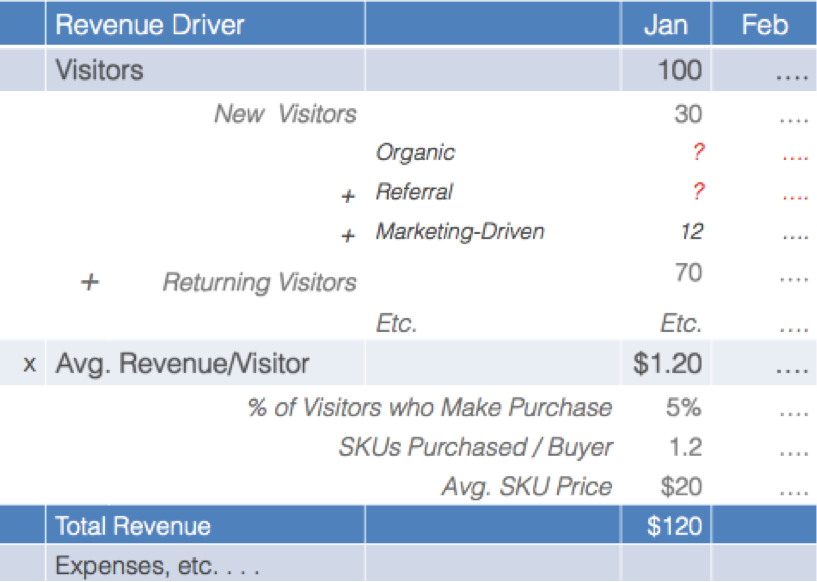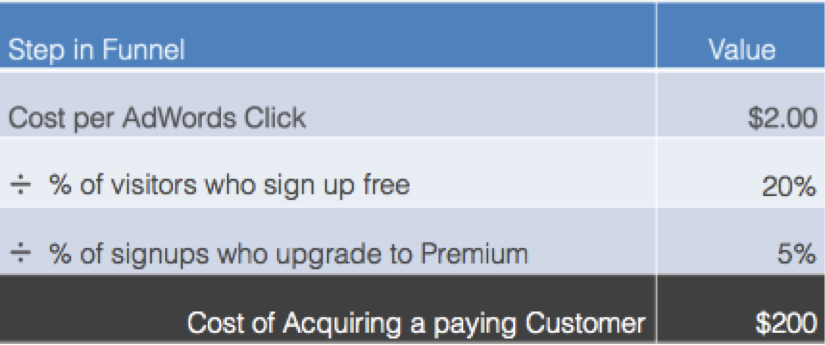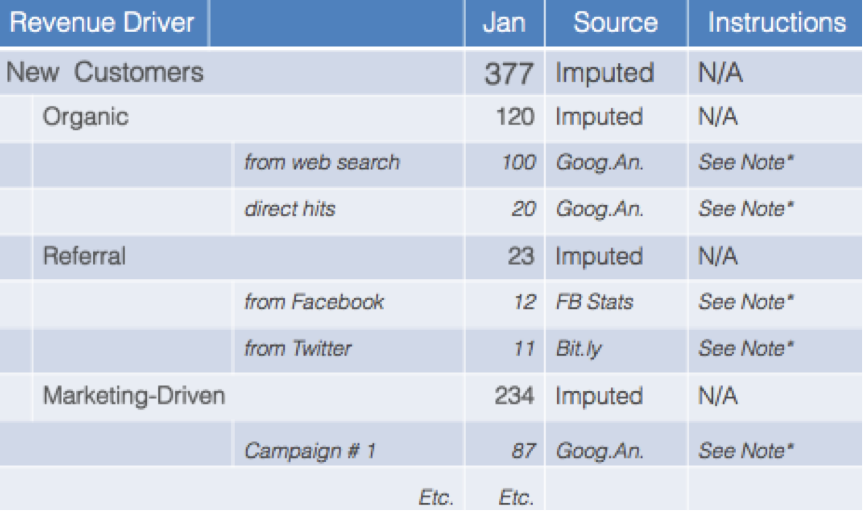How to put metrics on business service

It is very important for any company to track effective business metrics (internal and external). Correct quantitative indicators can help motivate the team, concentrate on primary tasks, make realistic forecasts, impress investors and build a dialogue with large companies.
One of the important skills that every novice manager or manager needs to master is the ability to create a culture based on the use of metrics.
')
The problem lies in the fact that learning to think as a business analyst is incredibly difficult! I have been in the shoes of Brainscape CEO for several years. All this time I have been learning how to manage quantitative indicators correctly, despite the fact that before that I had been working in economics, finance and statistics for almost 10 years. I read a lot of books and looked at endless feeds of posts, but they could not prepare me for working with business intelligence.
In this article I will try to summarize all the knowledge and skills that I acquired during the creation of the metric-oriented culture of Brainscape. I was lucky and I had the honor to share my thoughts with the audience of the General Assembly. I also acted as a Kaplan / TechStars EdTech accelerator mentor. It's time to tell you about metric approaches to business development.
1. Start with a mature business model.
Most of the literature on the company's growth indicators suggests that when starting your project, you have already identified some key performance indicators (KPIs) for yourself that you want to optimize. Want to increase user retention rates? Conduct cohort analysis. Want to measure audience engagement? Just calculate the ratio of daily and monthly user activity. Want to increase monetization? Lower customer churn rate and failure rate. Some companies need to keep track of these metrics. However, all companies are different. Considering the performance indicators in isolation from the specifics of the organization, you risk stopping to see the whole picture.
I do not recommend using conditional indicators and the first available tools (such as Google Analytics or MixPanel). Start building a company by developing a complete table of indicators that define your business model. This may be a general Google spreadsheet, written many months in advance. This will allow all project participants to explore the factors affecting business growth. Having painted the structure of the model, you will better understand your project and determine the data you need.
Business models can be divided into two types: monetization models that help evaluate all growth factors, and exit-to-market models that help evaluate the effectiveness of business expansion through marketing activities.
Let's take a look at them in more detail.
A. Monetization Models
You can regard monetization models as simply “inflated” profit and loss statements. In a good monetization model, in addition to monetary amounts, the sources of their receipt are indicated.
For example, if you have a jewelry store, the table may have the following lines:
- the number of visitors to the store;
- the percentage of people talking to the seller;
- the percentage of people who have made a purchase;
- average purchase price.
These indicators of profit (they need to be calculated every month) will be of interest to other project participants. The ability to see all sources of income at once is a very important first step towards the development of a company whose management is based on metrics. The spreadsheet shown below is just one of the ways to formalize sources of income. There are countless options for structuring business data, as each company is unique. You need to make a model that fits your business specialization.

If you have defined top-level indicators, you can “dig deeper” and highlight a few low-level ones. The image above shows a table of indicators for an e-commerce site. To calculate the amount of income, the following formula was applied:
Revenue = Number of visitors * Average purchase price
For a company of this type, it is important to determine the sources of customers - this will help to understand how the organization will go next month.
Remember that it will be most convenient to present the model as a hierarchical structure. Such an organization will allow you to identify gaps (items for which you have no data) that the current set of tools are not able to fill (such places are highlighted in red in the table above). We will solve this problem in the second section.
B. Market entry models
While monetization models are ways to optimize a business funnel, market entry models show how you can expand your business by filling this funnel with new resources. Entry models are of particular importance to venture capitalists, helping to determine how quickly a business will grow after a cash investment is injected, and how much profit it will bring. The basis of the entry-to-market model is the ratio of the profit that the customer will bring to the price that will have to be paid to attract it (LTV / CAC).
All marketing campaigns should be carried out taking into account the ratio of LTV / CAC: you need to make sure that your unit-economy really "converges".
Calculating the LTV metric: The LTV metric is much easier to calculate than the CAC. This is the amount of net profit that the company receives from the buyer, for all the time of cooperation. Here is the formula:
LTV = Revenue / Number of customers / Months * Average duration of customer interaction with the company (in months)
The form of the equation may vary depending on the specifics of the company, but its essence remains the same. In particular, this applies to projects that provide software by subscription, consulting firms and e-commerce sites. LTV is a lifetime customer value. LTV for a subscription software company with a monthly fee of $ 10 and an average subscription time of 10.5 months will be $ 105.
Calculating CAC: Unlike LTV, CAC can take many forms: literally, for each marketing channel of a company, its own indicator is calculated. If to simplify greatly, the formula for CAC can take the form:
CAC = Cost of receiving one subscriber / Percentage of subscribers who became buyers

A typical example of CAC is an ad campaign in Google AdWord. This example is so indicative that many start-ups start using it to estimate the cost of marketing while communicating with venture capitalists before the start of an active promotion campaign. The image shows a simplified process for calculating a CAC marketing campaign using Google AdWord for shareware services.
In other words, in this particular example, you need to spend $ 200 on Google Ads to get one paying customer (this is only if viral effects do not interfere, which will accelerate the growth of the company and lower the cost of attracting a customer). If the CAC is $ 200, that's a lot. In this case, the value of LTV should be very large.
As a rule, to attract investors' money, you need to set the ratio LTV / CAC in the amount of 3/1 (proving by this point that there is a market for the product). You need to show investors that after paying for a marketing campaign, your business will immediately grow. Even if the product is niche, a smart businessman tries to optimize the ratio of LTV / CAC - this allows you to increase sales.
Any new company must build both models (it is assumed that it has all the necessary data for this). Here only the data are not an element of paramount importance. Create the right framework to structure the data and demonstrate the viability of the project - take care of data collection later.
2. Prepare data collection tools
Now you have a reliable framework for structuring information that will allow you to tell the “history of your company” - it remains to provide it [history] with real data, so you should attend to finding the right tools to collect them. This may include web analytics tools (like Google Analytics or Kiss Metrics), mobile analytics (like Flurry), user survey tools, Quickbox financial information, export data from Salesforce.com, user queries to your database or any other toolbox that can provide the data needed to populate the table.

Perhaps you should consult with your programmers - they can help set up adequate integration, which will simplify the collection of data on each item. Do not underestimate this stage - to gather the necessary information, it will take some effort.
It is very important to indicate at every point where the data comes from, preferably right in the main Google table. Thus, it will be easier for you to transfer your functions of collecting information to another person. In Brainscape, in order not to clutter up the table, we brought out all the data collection algorithms in the “Notes” attached to the corresponding cells. The data collector simply hovers the mouse cursor over the cell of interest and follows the instructions.
3. Define monthly data collection and sharing processes.
This new common table of business models with data collection methodologies and clear instructions can now serve as the basis for organizing an ongoing data collection and exchange process. To do this, you will need to delegate part of their duties.
A. Hire a data collection assistant
Given that your story has a huge amount of points for which you need to collect data, you should shift some responsibility for collecting data on the shoulders of a junior employee or a virtual assistant. For example, the Brainscape model statistics is generated based on more than 300 sources that represent several complex elements of customer interaction funnels. I would not want to manage all incoming data by myself!
If your junior employees are not ready for this job (or, on the contrary, monotonous routine work is not the best use of their skills), you should hire a virtual assistant . Freelancers with services such as UpWork are ideal for such tasks and even, after a while, can start working with you on an ongoing basis.
B. Ensure information collectors have an adequate level of training.
It doesn’t matter how well written the data collection instructions are: when an employee starts processing incoming data flows, some erroneous values of the indicators will begin to manifest themselves. Work closely with him (or her) [employee] and let me ask you questions. Keep doing until you realize that the assembler is 100% complete the task.
C. Set a specific schedule
Most companies collect business model data once a month. Of course, there will always be situations when you need to analyze data in a shorter period of time — for example, when you evaluate the results of an experiment or test the effect of a new software release — however, for these cases you can always perform an ad hoc analysis using the time table . The KPI master record is likely to exist in a single copy and be consistent with the profit and loss statements, as well as other reporting tools.
Regardless of the frequency of data collection, you should set a reminder in the calendar (for yourself and the data collector) to know when data for the previous period becomes available. So you will not forget to check the results and share them with other project participants.
D. Make predictions and consider “what if” scenarios
A well-organized model of business growth indicators helps to assess not only the work done, but also the prospects. I recommend holding a vertical line in the table and separating it from the past months from the future ones (I additionally mark the future months in gray). Now you can edit formulas in the columns of the coming months in order to make sure that the planned growth is consistent with the current conversion rates.
To make the tables even more visual, I thought that you could highlight key “assumptions” in yellow. It seems to say: "Change the value of the cell and see what happens in the future." For example, if you want to illustrate the effect of a potential improvement in user retention or a subscriber conversion rate of 1%, you just need to correct the value in the yellow box and see how the prediction cells change.
Here is an example of a business model table. See the main tab and the details tab.
E. Share your results with other project members.
One of the best features of Google spreadsheets is access settings. You can make it so that only you and your assistant can edit the document. At the same time, you can allow investors to view the data, and members of the board of directors can comment on them. Thanks to the flexibility of Google tables, the same document can be used for different types of communication.
In most cases, I recommend to immediately share the results with the whole team (and ask to comment on them). Ask for the biggest changes. Once you understand everything, share the table with the board of directors (or a group of managers) and ask them to leave comments on any cell where they have questions. Thus, having discussed KPI in a “virtual” space, it will be easier for you to do this during verbal communication.
As for investors (and potential investors), here you are free to decide when to show the data. If you want to be completely open, you can show the entire table (of course, with read-only access), but you may want to share with them only a copy of the table stored in a separate file.
In general, your goal is to “automate” the process of collecting and sharing data as much as possible so that you don’t have to do it yourself every month. Creating a convincing story about a company’s activities based on its performance can be exhausting, therefore, the more authority to collect and exchange data you can delegate (be it a calendar or an assistant), the more mental resources you will have to analyze them.
4. Analyze the data and act in accordance with the information received.
Monthly team discussions of data often generate interesting topics for conversation. Is the market as big as we thought? Does this category of the population use our product more often than others? Do we really lose so many customers because of one webpage? An honest and modifiable table of a business model makes such discussions as productive and effective as possible.
Some indicators may not be large enough; some indicators may be higher than normal (which, sometimes, can be regarded as an advantage). Your actions are completely determined by the metric. To improve some of your performance indicators, you may need to involve focus groups, conduct A / B tests, send emails and mobile messages, implement new features in your product, or conduct targeted marketing campaigns. The ability to prioritize and respond correctly to changes in the value of indicators is a managerial skill that comes with experience.
5. Continually recycle your model.
I mentioned earlier that you need to automate the data collection process as much as possible. So, this is not entirely true. You should definitely divide the task of collecting data into blocks and transfer their parts to other people, only with the development of the business, the structure of the model will also change.
Each new feature or business specialization may entail a change in the main table and a review of all data collection instructions. You will have to update this table every time a project goes through another evolutionary step, otherwise you risk not understanding your own business.
Becoming a company whose management is based on quantitative indicators requires you to constantly strive to automate the collection of metrics, but this is not fully achieved. In his famous book “ Predictable Success, ” Les McKeown advises managers to take more risks during the formation of a structure for making informed decisions. It is impossible to achieve great accuracy of forecasting if, from the very beginning, one does not inculcate in the company a culture based on metrics.
 Announcement:
Announcement:October 1-3, 2015, Moscow will host the first Russian conference on methodologies Lean startup and Customer development: Lean Startup Russia 2015 .
You can participate in the first day of the conference free of charge and use the startuphub promo code, which gives a 10% discount on any ticket .
Source: https://habr.com/ru/post/294672/
All Articles